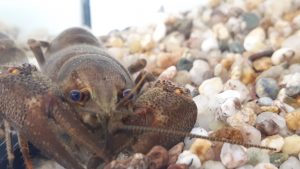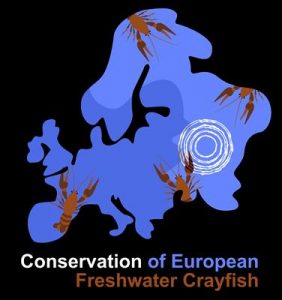Functional Environmental Genomics
Freshwater crayfish and their invasive disease in Europe
European Noble Crayfish (Astacus astacus) Foto: © Kathrin Theissinger
Institution: Senckenberg Gesellschaft für Naturforschung
SUMMARY

Biological invasions are the second largest contributor to the loss of biodiversity.
Decapods are a very diverse order of crustaceans. Among the decapods, freshwater crayfish are key species of aquatic ecosystems, with a strong impact on the biodiversity of their habitat. Despite their ecological and economic importance, crayfish are still very little explored at the genomic level. Crayfish are located among the Metazoans with the largest number of chromosomes (generally more than 170) and are characterized by considerable variations in the genome size, ranging from 2 Gb to more than 17 Gb. European freshwater crayfish are currently threatened by invasive North American freshwater crayfish species that naturally carry the oomycete pathogen Aphanomyces astaci. While North American crayfish are generally resistant to this pathogen, in European crayfish species it is causing a usually deadly disease called crayfish plague, resulting in severe population decimations all across Europe. This is particularly the case for the noble crayfish Astacus astacus, a´n endangered species of European aquatic ecosystems, although some populations seem to have developed resistance towards the disease.
This project aims to obtain a chromosome level reference genome for A. astacus. With an estimated size of 17Gb, this genome will be the largest genome available in invertebrates and will be exploited by comparative genomics and cytogenomics approaches to explore the evolution of decapod genomes, in terms of gene content, repeated elements and genome architecture, with specific focus on the sex determination system, which is still unknown in crayfish at present. In synergy, we will investigate the crayfish immune system and its evolution in decapods. First, we will identify the genes involved in the innate immune response in A. astacus by studying the differential gene expression in a controlled infection experiment across different tissues. While it has long been accepted that immune memory is absent in invertebrates, this notion has recently been challenged by the observation of immune memory responses in certain insects and crustaceans. Thus, we will attempt to demonstrate experimentally the existence of immune memory in A. astacus by an immune priming experiment, followed by single cell RNA sequencing of hemocytes. All the differentially expressed genes identified, whether they are already known or novel, will be studied in the light of their genomic and evolutionary context. Finally, we will exploit the host-pathogen model of A. astacus and Ap. astaci to shed light into their coevolutionary history. We will investigate the genetic basis of host resistance and pathogen virulence by utilizing GWAS approaches between susceptible and resistant crayfish populations and between strains of varying virulence in the pathogen. The genetic variants associated with host resistance will be used to create a SNP chip that will identify resistant crayfish populations, paving the way for an advanced management strategy to conserve freshwater crayfish.
Project members
Dr. Kathrin Theissinger, – CV
Prof. Dr. Miklos Bálint
Caterina Francesconi, – PhD candidate, University of Koblenz-Landau
Christelle Rutz, PhD candidate, University of Strasbourg
Ljudevit Luka Boštjančić, – Phd student
Lena Bonassin, – Erasmus trainee internship
Contributors
Prof. Dr. Odile Lecompte, University of Strasbourg
Dr. Anne Thielsch, University of Koblenz-Landau
Dr. Lucian Pârvulescu, West University Timisoara (Romania)
Dr. Sandra Hudina, University of Zagreb, Croatia
Dr. Javier Diéguez-Uribeondo, Royal Botanical Garden, Spain
Dr. Japo Jussila, University of Eastern Finland, Kuopio, Finland
Dr. Barbara Feldmeyer, LOEWE Centre for Translational Biodiversity Genomics, Frankfurt, Germany
GROUP EXPERTISE / METHODS
- whole genome and transcriptome de novo assembly and annotation
- RNAseq and gene expression analyses
- comparative genomics
- population genetics and genomics
GENOMES SEQUENCED
Noble crayfish Astacus astacus
(assembly in preparation)
Idle crayfish (Austropotamobius bihariensis) in preparation
